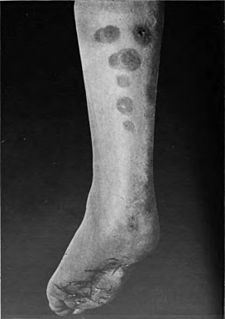
Erythema is redness of the skin or mucous membranes, caused by hyperemia in superficial capillaries. It occurs with any skin injury, infection, or inflammation. Examples of erythema not associated with pathology include nervous blushes.

Panniculitis is a group of diseases whose hallmark is inflammation of subcutaneous adipose tissue. Symptoms include tender skin nodules, and systemic signs such as weight loss and fatigue.

Livedo reticularis is a common skin finding consisting of a mottled reticulated vascular pattern that appears as a lace-like purplish discoloration of the skin. The discoloration is caused by swelling of the venules owing to obstruction of capillaries by small blood clots. The blood clots in the small blood vessels can be a secondary effect of a condition that increases a person's risk of forming blood clots, including a wide array of pathological and nonpathological conditions. Examples include hyperlipidemia, microvascular hematological or anemia states, nutritional deficiencies, hyper- and autoimmune diseases, and drugs/toxins.
ICD-10 is an international statistical classification used in health care and related industries.

Sweet's syndrome (SS), or acute febrile neutrophilic dermatosis is a skin disease characterized by the sudden onset of fever, an elevated white blood cell count, and tender, red, well-demarcated papules and plaques that show dense infiltrates by neutrophil granulocytes on histologic examination.
Necrolytic migratory erythema (NME) is a red, blistering rash that spreads across the skin. It particularly affects the skin around the mouth and distal extremities; but may also be found on the lower abdomen, buttocks, perineum, and groin. It is strongly associated with glucagonoma, a glucagon-producing tumor of the pancreas, but is also seen in a number of other conditions including liver disease and intestinal malabsorption.

Chemotherapy-induced acral erythema is reddening, swelling, numbness and desquamation on palms of the hands and soles of the feet that can occur after chemotherapy in patients with cancer. Hand-foot syndrome is also rarely seen in sickle-cell disease. These skin changes usually are well demarcated. Acral erythema typically disappears within a few weeks after discontinuation of the offending drug.
A paraneoplastic syndrome is a syndrome that is the consequence of cancer in the body, but unlike mass effect, is not due to the local presence of cancer cells. In contrast, these phenomena are mediated by humoral factors secreted by tumor cells or by an immune response against the tumor.
Erythema gyratum repens is a figurate erythema that is rapidly moving and usually a marker of underlying cancer, usually from the lung.
Neutrophilic eccrine hidradenitis (NEH) usually is a cutaneous complication of chemotherapy, but it can also occur for other reasons. It consists of fever and non specific skin lesions. It is rare, and self-limited.
Reactive neutrophilic dermatoses are a spectrum of conditions mediated by neutrophils, and typically associated with underlying diseases, such as inflammatory bowel disease and hematologic malignancy.
Urticarial vasculitis is a skin condition characterized by fixed urticarial lesions that appear histologically as a vasculitis.
Paraneoplastic acrokeratosis, Bazex syndrome is a cutaneous condition characterized by psoriasiform changes of hands, feet, ears, and nose, with involvement of the nails and periungual tissues being characteristic and indistinguishable from psoriatic nails. The condition is associated with carcinomas of the upper aerodigestive tract.
Papular purpuric gloves and socks syndrome is a cutaneous condition characterized by pruritus, edema, and erythema of the hands and feet, occurring primarily in teenagers and young adults.
Tripe palms also known as Acanthosis palmaris are a cutaneous condition characterized by ridged velvety lesions on the palms.
Rowell's Syndrome was described by Professor Neville Rowell and colleagues in 1963. Patients with the syndrome have lupus erythematosus, annular lesions of the skin like erythema multiforme associated with a characteristic pattern of immunological abnormalities. It is uncommon but occurs worldwide.
Necrolytic acral erythema is a cutaneous condition that is a manifestation of hepatitis C viral infection or zinc deficiency.







